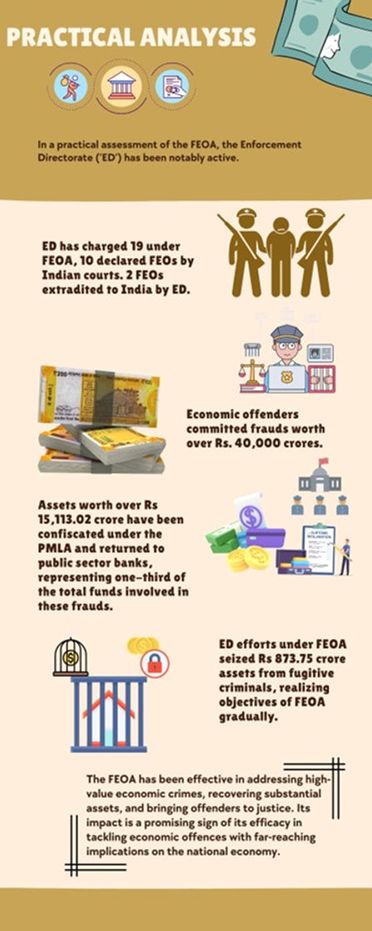The Fugitive Economic Offenders Act, 2018 ('FEOA') represents a pivotal shift in India's approach to combating economic crimes, specifically targeting offenders evading the legal system by absconding overseas. Aimed at safeguarding the banking sector and reinforcing legal integrity, the FEOA empowers authorities to confiscate assets of economic offenders pre-emptively, a significant deterrent to financial frauds impacting the economy. Highlighting its efficacy, the FEOA's application to high-profile cases highlights its role in compelling offenders to comply with legal proceedings. While the FEOA marks a substantial advancement in legal frameworks against economic offenses, ongoing adaptations are vital for addressing emerging challenges and ensuring comprehensive enforcement against all economic crimes, thereby fortifying India's economic and legal landscape.
Background
As India's population has grown steadily in recent years, so too has the number and variety of crimes committed, particularly economic crimes involving non-payment of bank loans. These activities have significantly impacted the stability of the banking sector in India. The FEOA was enacted with the primary aim of addressing the issues of economic offenders fleeing the country to evade the Indian legal process and avoid criminal prosecution, ensuring that these offenders face legal consequences in India. The FEOA targets individuals who have absconded or refuse to return to India to face criminal charges. A key feature of the FEOA is that it is for the confiscation of crime proceeds, property, and benami properties acquired by Fugitive Economic Offenders ('FEOs'), whether located within India or abroad. The FEOA serves to reinforce the integrity of the Indian judicial system by preventing economic offenders from escaping its reach.
Summary of FEOA
The primary objective of the FEOA is to uphold and strengthen the rule of law within the country. The FEOA acts as a deterrent by ensuring that individuals who commit economic crimes cannot avoid legal proceedings by staying outside of India's jurisdiction. It aims to maintain the integrity and effectiveness of India's legal framework while dealing with economic offences.
A quick bulletized summary of the FEOA is as follows:
Chapter 1: Preliminary
This chapter of the FEOA lays the foundation for the Act, covering basic provisions across three sections. These sections define the short title, extent and commencement, definitions, and outline its application.
- S. 2 of the FEOA interalia provides definitions for key terms such as 'Benami Property' and 'Benami Transaction', 'Contracting State', 'Fugitive Economic Offender', 'Proceeds of Crime', and 'Scheduled Offence'.
- S. 2(b) of the FEOA states that the terms 'benami property' and 'benami transaction' shall have the same meaning as provided in clauses (8) and (9) of s. 2 of the Prohibition of Benami Property Transactions Act, 1988 (45 of 1988).
- S. 2(c) of the FEOA defines a 'contracting state' as any country or territory outside India for which the Central Government has established arrangements with the respective government through a treaty or other means.
- S. 2(f) of the FEOA defines FEO as an individual against whom a warrant for arrest related to a scheduled offence has been issued by any court in India. It applies to individuals who have either left India to avoid criminal prosecution or are abroad and refuse to return to India to face criminal prosecution.
- S. 2(k) of the FEOA defines 'proceeds of crime' as any property derived or obtained, either directly or indirectly by any person because of engaging in criminal activity relating to a scheduled offence. This includes the value of such property. In cases where the property is situated or held outside the country, the equivalent value of the property held within the country or abroad is also considered.
- S. 2(m) of the FEOA defines a 'Scheduled Offence' as an offence listed in the schedule, provided that the total value associated with such offence, or multiple offences amounts to one hundred crore rupees or more.
- The applicability of FEOA is provided under s. 3 which provides that it is applicable to individuals who are or become an FEO on or after the 21st day of April.
Chapter 2: Declaration of FEO and Confiscation of Property
This chapter in the FEOA focuses on the process for formally declaring an individual as an FEO and the subsequent actions regarding their property.
- S. 4 of the FEOA outlines the procedure to declare an individual as FEO. The Director ('D') or Deputy Director ('DD'), with reasonable belief and evidence that the individual is a fugitive, can file an application to a Special Court ('SC') for such a declaration. This application must include the reasons for such belief, the whereabouts of the individual, list of his properties including benami properties, if any. and the details of persons who may have an interest in these properties. Additionally, it also provides that the authorities which are appointed under the Prevention of Money Laundering Act, 2002 ('PMLA') are designated for the FEOA.
- Under s. 5 of the FEOA, the D or DD is authorized, with the court's permission, to attach any property listed in the application. This power can be exercised before or after the application under s. 4 is filed provided that if this power has to be exercised before the filing of the application, certain conditions must be fulfilled: first, if there is a reasonable belief that the property is either proceeds of crime or is owned by an individual who is a FEO; and second, if there is a concern that the property might be dealt with in a manner that would make it unavailable for confiscation. However, it is mandated that the Director or the authorized officer must file an application under s. 4 before the SC within thirty days from the date of such attachment if they provisionally attach any property under this subsection.
- The D or DD have powers akin to a civil court under the Civil Procedure Code, 1908 ('CPC').
- Upon receiving an application under s. 4, the SC issues notice to the concerned individual and other interested parties. This notice requires them to appear at a specified place and time, set at a minimum of six weeks from the date of issue of the notice.
- If the individual fails to appear as required and is subsequently declared an FEO by the SC, their property becomes liable for confiscation by the SC. If an individual appears at a specified place and time the SC may terminate the proceeding against him.
- However, if an individual fails to appear either in person or through legal counsel, the SC may proceed with the hearing. After hearing the application, the SC may declare the individual a FEO.
- If the case where new properties are identified after filing the initial application the D or DD may file a supplementary application to include these assets.
- Once an individual is declared an FEO, they along with other associated entities are barred from filing any civil claims in any court or tribunal.
Chapter 3: Miscellaneous
This chapter of the FEOA encompasses a range of miscellaneous provisions that relate to the burden of proof, appeals, jurisdiction, legal protections, and the powers vested in the Central Government ('CG').
- S. 16 of the FEOA the responsibility for proving an individual's status as an FEO rests with the D or any person authorized by the D. This shifts the burden of proof onto the authorities responsible for enforcing the FEOA. Regarding appeals, any party seeking to challenge a judgment or order of the SC must do so at the High Court ('HC') within thirty days from the issuance of that judgment or order. The jurisdiction of civil courts is explicitly excluded in matters covered by the FEOA. These courts are neither authorized to try suits or proceedings related to the FEOA nor to issue injunctions in these cases. It also offers legal protection to the CG, the Presiding Officer of the SC D or DD They are shielded from any suit, prosecution, or legal proceeding if their actions under the FEOA are done in good faith.
- The CG is granted the authority to make alterations to the schedule of offences. It can either remove offences from the list or add new ones, depending on what it deems necessary or expedient. The provisions of the FEOA are designed to complement, not replace, other legal frameworks. This ensures that the FEOA works in harmony with existing laws, reinforcing the legal system without causing any jurisdictional conflicts or redundancies.
Critical Analysis - Issues in the FEOA
This chapter of the FEOA encompasses a range of miscellaneous provisions that relate to the burden of proof, The constitutionality of the FEOA has been subject to critical analysis, raising concerns regarding its adherence to constitutional principles and legal standards.
One key issue pertains to the confiscation of property before formally declaring an individual as a FEO. S. 5(2) of the FEOA allows for property confiscation based on suspicion, without affording the individual an opportunity to defend themselves. This provision appears to contravene the constitutional guarantee of equality before the law and the principle of natural justice, which presumes innocence until proven guilty.
Another constitutional concern arises from the restriction imposed on FEOs regarding their ability to put forward or defend civil claims. S. 14 of the FEOA limits access to justice by preventing FEOs from pursuing or defending civil claims, potentially infringing upon the fundamental right enshrined in Article 21 of the Constitution. The absence of a specified time frame for hearing applications under s. 4 of the FEOA poses a legal challenge, as it could lead to delays in court proceedings, allowing suspected offenders to evade justice.
Furthermore, the selective applicability of the FEOA, targeting only economic offenders involved in high-value crimes exceeding Rs. 100 crores, raises questions about its comprehensiveness.
However, the FEOA's unique features distinguish it from other laws in addressing economic offences. Its global reach enables the confiscation of properties, including those abroad, preventing offenders from evading legal processes. Moreover, the FEOA's proactive approach, allowing pre-emptive property confiscation before formal declaration as an FEO, reflects a strong intent to combat economic crimes effectively.
The pictorial representation below analyses the practical impact of FEOA and showcases its tangible success in combatting economic offences.

Conclusion
The enactment of the FEOA emphasizes a significant evolution in India's strategy to combat economic offences, affirming the government's dedication to preserving economic stability and fostering investor trust. Distinct from preceding laws, which were entangled in procedural delays and complexities, the FEOA establishes a vigorous framework for prompt action against perpetrators of high-value economic crimes. This legislation empowers authorities to pre-emptively secure assets, closing legal gaps previously exploited by offenders to dodge accountability.
However, the path forward demands careful navigation of obstacles similar to those faced by laws like the PMLA which have not entirely succeeded in curtailing the transfer of large sums to offshore accounts. The FEOA's continued success will depend on its flexibility and the government's commitment to refining this legislative tool, thereby enhancing India's economic resilience and legal robustness in countering economic crimes
The content of this article is intended to provide a general guide to the subject matter. Specialist advice should be sought about your specific circumstances.
We operate a free-to-view policy, asking only that you register in order to read all of our content. Please login or register to view the rest of this article.


